Recent searches
Loading...
832-404487 - Humpback whale (Megaptera novaeangliae) up to the pectoral fin above the water surface, rocky coastline behind, Kenai Fjords National Park, Alaska, USA, North America
860-289798 - Adult, female Humpback whale (Megaptera novaeangliae) breaching, Reunion, overseas department and region of the French Republic and an Indian Ocean island in East Africa
832-389412 - Pectoral fin, Red Lionfish (Pterois volitans) detail, Pacific, Great Barrier Reef, UNESCO World Heritage, Australia, Oceania
1116-47623 - Humpback whale (Megaptera novaeangliae) pectoral fin, Lahaina, Maui, Hawaii, United States of America
1116-48662 - Humpback whale pectoral fin, Lahaina, Maui, Hawaii, United States of America
1116-47619 - Humpback whale (Megaptera novaeangliae) pectoral fin, Lahaina, Maui, Hawaii, United States of America
1116-46828 - A calf imitates its mother swimming upside down. The sperm whale (Physeter macrocephalus) is the largest of all the toothed cetaceans. Males can reach 60 feet in length. Photographed in the Indian Ocean off the coast of Sri Lanka, Sri Lanka
1116-46825 - Typical of this family the Blackside hawkfish (Paracirrhites forsteri) has thick spines in it's pectoral fins to aid staying in place on it's coral perch, Hawaii, United States of America
1116-41506 - A split image of a pair of humpback whales (Megaptera novaeangliae) underwater and above, Maui, Hawaii, United States of America
1116-41507 - A split image of a pair of humpback whales (Megaptera novaeangliae) underwater in front of the West Maui Mountains just south of Lahaina, Maui, Hawaii, United States of America
1116-41392 - A mother and calf pair of humpback whales (Megaptera novaeangliae) at the surface of the water off the island of Maui, Hawaii, United States of America
1116-41393 - Humpback whale (Megaptera novaeangliae) diving through the surface of the water, Hawaii, United States of America
1116-41391 - The island of Lanai is in the background of this breaching Humpback whale (Megaptera novaeangliae), Lanai, Hawaii, United States of America
1116-39962 - Blacktip Reef Shark (Carcharhinus melanopterus), Yap, Micronesia
1116-39970 - Humpback Whale (Megaptera novaeangliae) just about to break the surface to take a breath, Hawaii, United States of America
1116-39961 - This female Blacktip Reef Shark (Carcharhinus melanopterus) has a bite mark near her pectoral fin. This is likely a wound from a mating attempt, Yap, Micronesia
1116-39969 - An aerial view of a Humpback Whale (Megaptera novaeangliae) just below the surface, Lanai City, Lanai, Hawaii, United States of America
1116-39972 - Humpback Whale (Megaptera novaeangliae) underwater, Hawaii, United States of America
1116-40052 - Humpback whale (Megaptera novaeangliae) breaching, Lahaina, Maui, Hawaii, United States of America
1116-39973 - An aerial view of a Humpback Whale (Megaptera novaeangliae) at the surface of the water, Lanai City, Lanai, Hawaii, United States of America
1116-39971 - Humpback Whale (Megaptera novaeangliae) rolls over just below the surface, Hawaii, United States of America
1174-4673 - Squirrelfish (Holocentrus adscensionsis) finds shelter near a large Barrel sponge.
860-285216 - Humpback whales swimming at the surface, Sea of ??Cortez
860-285218 - Humpback whales pectoral fin at surface, Sea of ??Cortez
869-4152 - humpback whale A mother and calf surface off the island of Maui Hawaii
869-4169 - humpback whale Breaching Humpback whale Megaptera novaeangliae Hawaii
869-4154 - humpback whale breaching whale in front of Lahaina Maui Hawaii
869-4155 - humpback whale whale calf leaves it's mother for a close look at the camera Hawaii
990-170 - The distinctive colouration pattern of a Minke whale (Balaenoptera acutorostrata). Note that the typical white flipper band extends on to the lower side of the pectoral fin. St. Lawrence estuary, Canada (RR)
1116-30333 - Hawaii, Maui, Humpback whale breaching with island in the background.
1116-30336 - Hawaii, Maui, Humpback whale breaching with island in the background.
1116-30932 - Hawaii, galapagos shark with sunburst in background, (Carcharhinus galapagensis).
1116-31122 - Hawaii, This image captures the split second when this breaching humpback whale (Megaptera novaeangliae) is completely airbore. An incredible feat for this enormous leviathan.
1116-30318 - Hawaii, Maui, Humpback whale fluking its tail.
1116-30326 - Hawaii, Maui, Close-up of Humpback whale near the oceans surface.
1116-33291 - Hawaii, Humpback Whale (Megaptera novaeangliae) breaching.
1116-33281 - Hawaii, The pectoral fin of a humpback whale (Megaptera novaeangliae).
1116-30317 - Hawaii, Maui, Humpback whale fluking its tail.
1116-29310 - Hawaii, Maui, Humpback whale breaching.
1116-38624 - Alaska, Inside Passage, Humpback Whale (Megaptera novaeangliae) breaching B2006
1116-38745 - Mexico, Humpback Whale (Megaptera novaeangliae) breaching, close-up C2029
1116-33296 - Hawaii, Humpback Whale (Megaptera novaeangliae) breaching.
1116-31299 - Hawaii, The oriental flying gurnard (Dactylopterus orientalis) is remarkable for its enormous pectoral fins. When spread, they have the form of rounded fanlike wings.
1116-31298 - Hawaii, The oriental flying gurnard (Dactylopterus orientalis) is remarkable for its enormous pectoral fins. When spread, they have the form of rounded fanlike wings.
1116-38619 - Alaska, Inside Passage, Humpback Whale (Megaptera novaeangliae) breach B2005
1116-30334 - Hawaii, Maui, Humpback whale breaching with island in the background.
1116-31107 - Hawaii, Maui, Lahaina, A photograher on a whale watching boat out of got a close up look at the tail of a humpback whale (Megaptera novaeangliae).
1116-30324 - Hawaii, Maui, Close-up of Humpback whale near the oceans surface.
1116-29862 - Hawaii, Maui, Close-up of Humpback whale near the oceans surface.
1116-30319 - Hawaii, Maui, Humpback whale fluking its tail.
1116-30323 - Hawaii, Maui, Close-up of Humpback whale near the oceans surface.
1116-32567 - Hawaii, galapagos shark (Carcharhinus galapagensis) baring teeth at surface.
1116-29219 - Caribbean, Bonaire, Great Barracuda (Sphyraena Barracuda).
1116-34350 - Hawaii, Humpback whale (megaptera novaeangliae) swimming in deep blue ocean.
1116-33348 - Hawaii, Humpback Whale (Megaptera novaeangliae) mother and calf, megaptera novaeangliae
1116-30328 - Hawaii, Maui, Humpback whale breaching with island in the background.
1116-29223 - Caribbean, Bonaire, Great Barracuda (Sphyraena Barracuda).
1116-32568 - Hawaii, galapagos shark (Carcharhinus galapagensis) baring teeth at surface.
1116-33300 - Hawaii, Humpback Whale (Megaptera novaeangliae) breaching.
1116-33575 - Hawaii, Front half of scalloped hammerhead shark (Sphyrna lewini)
1116-33346 - Hawaii, Humpback Whale (Megaptera novaeangliae) breaching.
1116-33297 - Hawaii, Humpback Whale (Megaptera novaeangliae) breaching.
1116-32587 - Hawaii, Oahu, North Shore, Galapagos shark showing teeth at surface.
1116-30335 - Hawaii, Maui, Humpback whale breaching with island in the background.
1116-30329 - Hawaii, Maui, Humpback whale breaching.
1116-33292 - Hawaii, Humpback Whale (Megaptera novaeangliae) breaching.
1116-33301 - Hawaii, Humpback Whale (Megaptera novaeangliae) breaching.
1116-36067 - Humpback Whale (Megaptera novaeangliae) underwater in the Pacific Ocean
1116-38740 - Mexico, Humpback Whale (Megaptera novaeangliae) breaching, close-up C2025
1116-33315 - Hawaii, Big Island, Kona, Whale Shark (Rhiniodon typus) with mouth wide open
1116-30337 - Hawaii, Maui, Humpback whale breaching.
1116-30325 - Hawaii, Maui, Close-up of Humpback whale near the oceans surface.
1116-30327 - Hawaii, Maui, Close-up of Humpback whale near the oceans surface.
1116-33278 - Hawaii, Humpback Whale (Megaptera novaeangliae) showing baleen.
1116-33276 - Hawaii, Humpback Whale (Megaptera novaeangliae) breaching.
1116-38630 - Alaska, Inside Passage, Humpback Whale, breaching (Megaptera novaeangliae) B2003
1116-33573 - Hawaii, Front half of scalloped hammerhead shark (Sphyrna lewini)
1116-35760 - Hawaii, Humpback Whale (Megaptera novaeangliae), [For use up to 13x20 only]
1116-36064 - Humpback Whale (Megaptera novaeangliae) underwater in the Pacific Ocean
1116-29863 - Hawaii, Maui, Humpback whale breaching with island in the background.
1116-33290 - Hawaii, Humpback Whale (Megaptera novaeangliae) breaching.
1116-30316 - Hawaii, Maui, Humpback whale fluking its tail.
1116-29194 - Indonesia, Komodo, Close-up of parrotfish scales and pectoral fin.
1116-30320 - Hawaii, Maui, Humpback whale fluking its tail.
1116-30332 - Hawaii, Maui, Kaanapali, Humpback whale breaching with island in the background.
1116-32588 - Hawaii, Oahu, North Shore, Galapagos shark showing teeth at surface.
1116-30322 - Hawaii, Maui, Humpback whale fluking its tail.
1116-33280 - Hawaii, Humpback Whale (Megaptera novaeangliae) breaching.
1116-32585 - Hawaii, Oahu, North Shore, Galapagos shark showing teeth at surface.
1116-33577 - Hawaii, Scalloped hammerhead shark (Sphyrna lewini)
1116-33289 - Hawaii, Humpback Whale (Megaptera novaeangliae) breaching.
1116-31118 - Hawaii, Breaching Humpback whale, (Megaptera novaeangliae).
1116-30321 - Hawaii, Maui, Humpback whale fluking its tail in golden sunset.
1074-33 - Humpback whale (Megaptera novaeangliae) with long pectoral fin held out of the water in front of boat full of whale-watchers. HusavÌk, Iceland
988-91 - Eurasian river otter (Lutra lutra) having caught Greater spotted dogfish (Scyliorhinus stellaris). The otter took only the innards of the dogfish by opening a short section of skin behind the pectoral fin (see images under 'Greater spotted dogfish'). Hebrides, Scotland (RR)
988-63 - Eurasian river otter (Lutra lutra) having caught Greater spotted dogfish (Scyliorhinus stellaris). The otter took only the innards of the dogfish by opening a short section of skin behind the pectoral fin (see images under 'Greater spotted dogfish'). The rest of the fish, still alive, was left on the shore and never retrieved. Perhaps the tough shark skin and battling fish are too much work when other food is plentiful? Hebrides, Scotland
1074-13 - Minke whale (Balaenoptera acutorostrata) spy hopping with white fins and rostrum visible. Husavik, Iceland
988-85 - Eurasian river otter (Lutra lutra) eating Greater spotted dogfish (Scyliorhinus stellaris). The otter took only the innards of the dogfish by opening a short section of skin behind the pectoral fin (see images under 'Greater spotted dogfish'). The rest of the fish, still alive, was left on the shore and never retrieved. Perhaps the tough shark skin and battling fish are too much work when other food is plentiful? Hebrides, Scotland
931-53 - Short finned pilot whale (Globicephala macrorynchus). A male pilot whale surfaces at speed. Gulf of California.
985-11 - Humpback whale (Megaptera novaeangliae) breaching with long, white pectoral fin visible. Hawaii, USA. (See also image: ...1025MW)
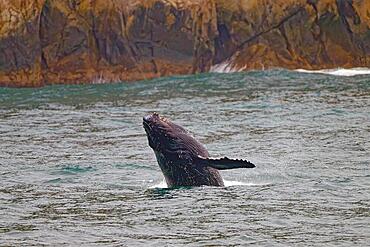

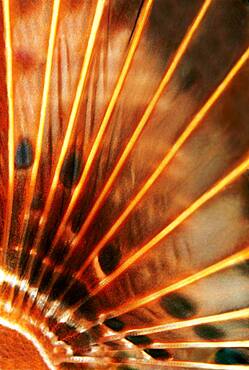






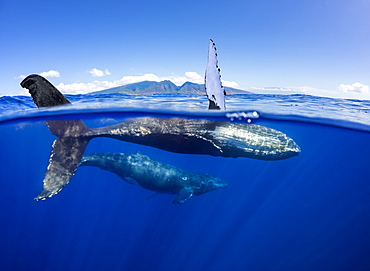














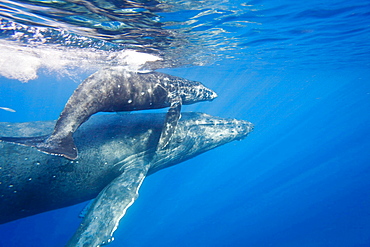















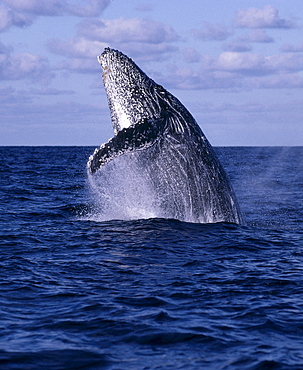




































![Hawaii, Humpback Whale (Megaptera novaeangliae), [For use up to 13x20 only]<br />1116-35760 Hawaii, Humpback Whale (Megaptera novaeangliae), [For use up to 13x20 only]](https://images.robertharding.com/zoom/RM/RH/HORIZONTAL/1116-35760.jpg)





















